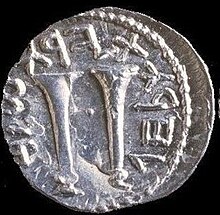This article needs additional citations for verification. (January 2023) |
Chazozra, also hazozra, hasosrah, hasoserah, plural chazozrot, hasoserot was a natural trumpet used in religious rituals by the Israelites, made of bronze, silver or silver alloys. The chazozra is mentioned 31 times in the Old Testament and is translated tuba in the Vulgate.[1] The first written description of the chazozra is probably recorded in the 4th book of Moses. The prophet Moses is from Elohim prompted: "And the LORD spoke to Moses and said: Make two trumpets of beaten silver..." (4 Mos 10)


The straight metal trumpet chazozra can be distinguished from the curved natural horn shofar by its design. While the word shofar derives from Akkadian, chazozra is based on the Hebrew consonant root ḤṢR (“housing”, “fence”, derived “tube”). The shape, but not the name, appears to have been imported from Egypt, deriving from the simpler Egyptian military trumpet sheneb, which produced only two notes. The chazozra was usually played in pairs.[2] While the chazozra is attributed to the institutionalized sacred area and the circle of power of the Second Temple, the shofar was part of the magical-mystical worship of God[3]

According to the Bible, the dedication of Solomon's temple included “…120 priests who blew trumpets. And it was as if it were someone who trumpeted..., as if a voice could be heard praising and thanking the LORD." ( 2 Chr 5,12-13)
When the Second Temple was destroyed in 70 A.D. at the end of the Jewish War, the stolen temple equipment was taken to Rome. An illustration of this can be found in the form of two reliefs on the Arch of Titus in Rome (approx. 70 A.D.), which were only added later, around 190 A.D. Flavius Josephus states the length of a chazozra in his book Antiquities of the Jews as a "bare cubit" (approx. 46 cm).
See also edit
Literature edit
- Edward H. Tarr: The Trumpet . Schott, Mainz 1984. ISBN 3-7957-2357-4
References edit
- ^ Abraham Zevi Idelsohn: Jewish Music - Its Historical Development . Henry Holt & Company, New York, 1929, pp. 10f
- ^ David Wulstan, The Sounding of the Shofar. In: The Galpin Society Journal, Vol. 26, May 1973, pp. 29-46, here pp. 30,41
- ^ Joachim Braun: Biblical musical instruments. IV Instruments. 4. ḥǎṣôṣrā. In: MGG Online, November 2016